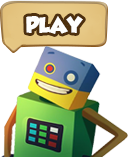يمكن أن يعلم روبوجاردن أي شخص البرمجة. يبدأ بالأوامر الأساسية ويعلم أي شخص مفاهيم البرمجة اللازمة حتى عند الانتهاء من إعداد المتعلم للمساعدة في تلبية الطلب الهائل على المبرمجين في أعمال القرن الواحد والعشرين.

التعلم القائم على القصه .. بإستخدام الرسومات

التعلم القائم على تنفيذ المهام .. التحدي جاهز

دروس تعليمية خطوة بخطوة ... بإستخدام نظام التلميحات
دروسنا لا تشجع على العنف وتشمل الأسس الأخلاقية والتعاليم في جميع رحلاتنا.
نحن واثقون بأن روبوجاردن سيقوم بتدريس البرمجة بكل سهولة وإلا فإننا سنعيد أموالك!
تتم معالجة جميع معاملات الدفع وتأمينها بواسطة Stripe. نحن لا نخزن أي معلومات عن بطاقة الائتمان.
يتوفر فريق الدعم المخصص لدينا على مدار الساعة طوال أيام الأسبوع ونحن على استعداد لمساعدتك في الاستمتاع بتجربة بدون توقف.
يتم تطبيق طريقة روبوجاردن الثورية لتعليم لغات البرمجة من المبتدئين إلى المستوى الاحترافي في 8+ رحلات لتدريس جافاسكريبت وبايثون.
يصبح المتعلم على دراية بمفاهيم البرمجة بالإضافة إلى بنية الجملة الأساسية.
يتعلم الطالب هيكل البرنامج الكامل الخاص بلغة البرمجة ويصبح أكثر دراية ببناء الجمل البرمجية.
يصبح المتعلم جاهزًا للانضمام إلى التطبيقات الاحترافية في البيئة المهنية والبرامج.

A loop is describes the repetition of a certain command or a piece of code that needs to be executed over and over again. Python, like other languages, has two main types of loops: the while loop and the for loop. A for loop is a control statement that iterates, or repeats, a piece of code a specific number of times. A while loop is a control statement that iterates a piece of code until a condition you specify becomes true.
There are several ways that can manipulate a loop. The break command stops a loop before the natural exit condition of the loop is met. If you want to continue the loop's execution at the same place you broke, the continue command begins reading the code again wherever the loop stopped.
The range command specifies the number of times you want to execute a for loop. For instance, if you want to loop over a statement four times, you can write:
For i in range(4):
By default, the range starts at 0 and increments by 1. The loop ends at the number you specified, so in the example of range(4) the loop will execute five times as the computer counts from 0 to 4.
You can start counting from a different number by adding the starting number in the brackets: range(2,6). You can also change the increment value by adding the value of the increment in the brackets: range(2,2,6). In this case, the loop will start at 2 and increase by 2 until it finishes at 6.
While loops are similar to for loops except that the condition that specifies when the loop will end is included after the while keyword. For instance, if you want to have the loop continue to run while a variable called x is less than 3, you would write:
While x<3:
In this example, the loop will keep going until the value of the variable x reaches a value of 3 or greater. This will only occur if the value of x changes as the loop runs; otherwise, the loop will run forever.
Do you want to practice more and get familiar with this awesome language? You can build wonderful apps as you improve your programming skills. Start your learning journey with RoboGarden now. Register for free.
Let's start python coding with RoboGarden learning journey.

